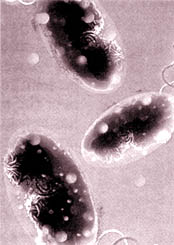Catching the real culprit
 a virus attacks a bacterium and turns the microbe into a lethal organism. The toxin that the cholera causing bacteria Vibrio cholerae produces, is in fact secreted by a virus that rides the bacterium in order to gain an entry into the cells. This startling discovery has been made by John Mekalanos and Matthew Waldor at the Harvard Medical School in the us . ( New Scientist ; Vol 151, No 2037)
a virus attacks a bacterium and turns the microbe into a lethal organism. The toxin that the cholera causing bacteria Vibrio cholerae produces, is in fact secreted by a virus that rides the bacterium in order to gain an entry into the cells. This startling discovery has been made by John Mekalanos and Matthew Waldor at the Harvard Medical School in the us . ( New Scientist ; Vol 151, No 2037)
Though viruses have long been suspected of interfering with the genetic material of the bacteria they attack, this is the first time that the mechanism of the act has been unravelled. Several bacterial diseases like diptheria and botulism are triggered by toxins from viruses that infect them. Researchers at the Harvard Medical School suggest that there is an entire family of threadlike viruses that turn the bacteria nasty, inducing toxin formation and causing diseases.
While Vibrio cholerae normally lives in coastal waters, a small minority survives in the gut and causes disease. It was in 1987 that Mekalanos and his colleagues set out to solve a mystery that intrigued them. They found that the key difference between the disease causing strain and its harmless counterpart is the presence of thousands of hair-like fibres, called pilli, with which they attach themselves to the gut cells of the host. It was clear to the researchers that the strains produced their lethal toxins only when the pilli were present. This started a decade long investigation that zeroed in on identifying a virus that hitchhikes the bacteria, turning them into killers.
This major finding nullifies the evil reputation of the cholera bacterium, putting the responsibility on a deadly virus called ctx . The mechanism that ctx adopts is deceptive. It finds its way into the bacterium through the pilli, using them as its receptors. It then introduces its gene that encodes the disease causing toxin into the genome of the infected bacterium. Scientists suspected the hand of a virus in turning V cholerae into a potent pathogen, when they found that the sequence of gene which encodes the cholera toxin in disease causing strains is capable of hopping from one bacterium to another. Besides, some particles outside the bacteria were found to bear the dna that matched the toxin-encoding genes.
"The ctx virus has not evolved within V Cholerae but its original host was a bacterium that perhaps infected a marine mammal such as a dolphin or a whale', says Mekalanos. Researchers believe that the virus must have infiltrated a once harmless strain of V cholerae to create the strain responsible for the first great cholera pandemic of 1817. Another infiltration by the same virus created the El Tor strain, that began the more recent pandemic in 1961. "The outbreaks that have affected Peru, South Asia and Zaire in the 1990s appear to be relatives of earlier strains and so are unlikely to be caused by new infiltrations', says Mekalanos.
Hailing the new discovery as
